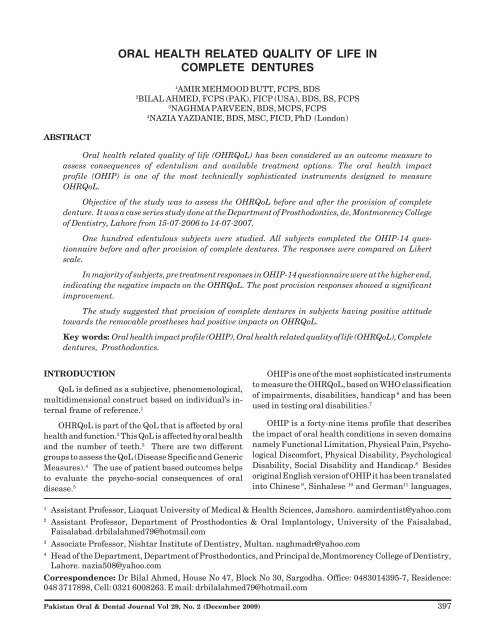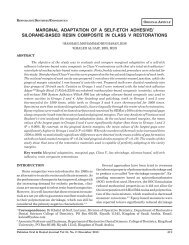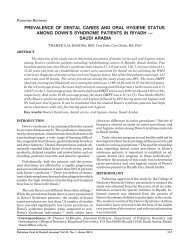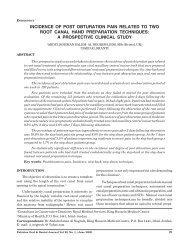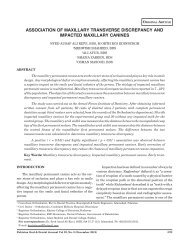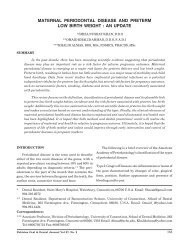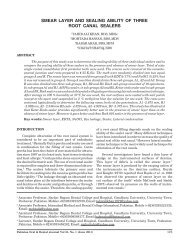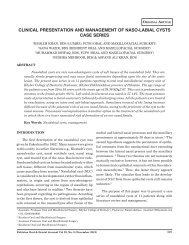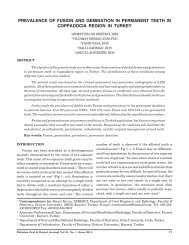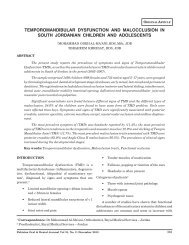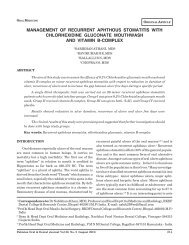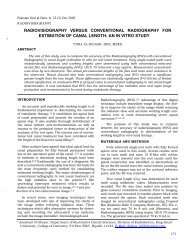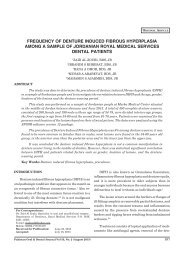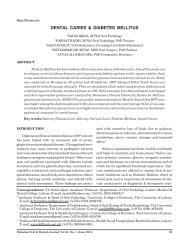Oral health related quality of life in complete dentures
Oral health related quality of life in complete dentures
Oral health related quality of life in complete dentures
- No tags were found...
Create successful ePaper yourself
Turn your PDF publications into a flip-book with our unique Google optimized e-Paper software.
<strong>Oral</strong> Health Related Quality <strong>of</strong> Life <strong>in</strong> Complete DentureORAL HEALTH RELATED QUALITY OF LIFE INCOMPLETE DENTURES1AMIR MEHMOOD BUTT, FCPS, BDS2BILAL AHMED, FCPS (PAK), FICP (USA), BDS, BS, FCPS3NAGHMA PARVEEN, BDS, MCPS, FCPS4NAZIA YAZDANIE, BDS, MSC, FICD, PhD (London)ABSTRACT<strong>Oral</strong> <strong>health</strong> <strong>related</strong> <strong>quality</strong> <strong>of</strong> <strong>life</strong> (OHRQoL) has been considered as an outcome measure toassess consequences <strong>of</strong> edentulism and available treatment options. The oral <strong>health</strong> impactpr<strong>of</strong>ile (OHIP) is one <strong>of</strong> the most technically sophisticated <strong>in</strong>struments designed to measureOHRQoL.Objective <strong>of</strong> the study was to assess the OHRQoL before and after the provision <strong>of</strong> <strong>complete</strong>denture. It was a case series study done at the Department <strong>of</strong> Prosthodontics, de, Montmorency College<strong>of</strong> Dentistry, Lahore from 15-07-2006 to 14-07-2007.One hundred edentulous subjects were studied. All subjects <strong>complete</strong>d the OHIP-14 questionnairebefore and after provision <strong>of</strong> <strong>complete</strong> <strong>dentures</strong>. The responses were compared on Likertscale.In majority <strong>of</strong> subjects, pre treatment responses <strong>in</strong> OHIP-14 questionnaire were at the higher end,<strong>in</strong>dicat<strong>in</strong>g the negative impacts on the OHRQoL. The post provision responses showed a significantimprovement.The study suggested that provision <strong>of</strong> <strong>complete</strong> <strong>dentures</strong> <strong>in</strong> subjects hav<strong>in</strong>g positive attitudetowards the removable prostheses had positive impacts on OHRQoL.Key words: <strong>Oral</strong> <strong>health</strong> impact pr<strong>of</strong>ile (OHIP), <strong>Oral</strong> <strong>health</strong> <strong>related</strong> <strong>quality</strong> <strong>of</strong> <strong>life</strong> (OHRQoL), Complete<strong>dentures</strong>, Prosthodontics.INTRODUCTIONQoL is def<strong>in</strong>ed as a subjective, phenomenological,multidimensional construct based on <strong>in</strong>dividual’s <strong>in</strong>ternalframe <strong>of</strong> reference. 1OHRQoL is part <strong>of</strong> the QoL that is affected by oral<strong>health</strong> and function. 2 This QoL is affected by oral <strong>health</strong>and the number <strong>of</strong> teeth. 3 There are two differentgroups to assess the QoL (Disease Specific and GenericMeasures). 4 The use <strong>of</strong> patient based outcomes helpsto evaluate the psycho-social consequences <strong>of</strong> oraldisease. 5OHIP is one <strong>of</strong> the most sophisticated <strong>in</strong>strumentsto measure the OHRQoL, based on WHO classification<strong>of</strong> impairments, disabilities, handicap 6 and has beenused <strong>in</strong> test<strong>in</strong>g oral disabilities. 7OHIP is a forty-n<strong>in</strong>e items pr<strong>of</strong>ile that describesthe impact <strong>of</strong> oral <strong>health</strong> conditions <strong>in</strong> seven doma<strong>in</strong>snamely Functional Limitation, Physical Pa<strong>in</strong>, PsychologicalDiscomfort, Physical Disability, PsychologicalDisability, Social Disability and Handicap. 8 Besidesorig<strong>in</strong>al English version <strong>of</strong> OHIP it has been translated<strong>in</strong>to Ch<strong>in</strong>ese 9 , S<strong>in</strong>halese 10 and German 11 languages,1Assistant Pr<strong>of</strong>essor, Liaquat University <strong>of</strong> Medical & Health Sciences, Jamshoro. aamirdentist@yahoo.com2Assistant Pr<strong>of</strong>essor, Department <strong>of</strong> Prosthodontics & <strong>Oral</strong> Implantology, University <strong>of</strong> the Faisalabad,Faisalabad. drbilalahmed79@hotmail.com3Associate Pr<strong>of</strong>essor, Nishtar Institute <strong>of</strong> Dentistry, Multan. naghmadr@yahoo.com4Head <strong>of</strong> the Department, Department <strong>of</strong> Prosthodontics, and Pr<strong>in</strong>cipal de,Montmorency College <strong>of</strong> Dentistry,Lahore. nazia508@yahoo.comCorrespondence: Dr Bilal Ahmed, House No 47, Block No 30, Sargodha. Office: 0483014395-7, Residence:048 3717898, Cell: 0321 6008263. E mail: drbilalahmed79@hotmail.comPakistan <strong>Oral</strong> & Dental Journal Vol 29, No. 2 (December 2009)397
<strong>Oral</strong> Health Related Quality <strong>of</strong> Life <strong>in</strong> Complete Denturedemonstrat<strong>in</strong>g cross-cultural equivalence. 12 Later on,Short form <strong>of</strong> OHIP-14 was developed, where the fullbattery <strong>of</strong> 49 questions is <strong>in</strong>appropriate. 13Complete <strong>dentures</strong> are the most common form <strong>of</strong>prosthetic rehabilitation for edentulism. 14 In Pakistan,<strong>complete</strong> edentulism occupies an estimated 4.1 %<strong>of</strong> the population aged 65 years and above, with aprojected <strong>in</strong>crease to 9.3 % by 2030. 15 OHRQoL hasbeen considered as an outcome measure to assess theimpact <strong>of</strong> edentulism and available treatments measuredby OHIP. 16number <strong>of</strong> studies were conducted on patientstreated with conventional <strong>complete</strong> <strong>dentures</strong> or implantreta<strong>in</strong>ed <strong>complete</strong> <strong>dentures</strong>. 17 One study compar<strong>in</strong>gOHRQoL <strong>of</strong> older adults wear<strong>in</strong>g <strong>complete</strong> andpartial <strong>dentures</strong> confirmed that removable partial dentureusers experience more impaired OHRQoL than<strong>complete</strong> <strong>dentures</strong> wearers. 18MATERIALS AND METHODSThis study was done to assess the OHRQoL beforeand after the provision <strong>of</strong> <strong>complete</strong> denture <strong>in</strong> subjectsrequest<strong>in</strong>g <strong>complete</strong> denture for the first time. Itwas conducted <strong>in</strong> the Department <strong>of</strong> Prosthodontics,de,Montmorency College <strong>of</strong> Dentistry, Lahore from15 th July 2006 - 14 th July 2007. It was a purposive, nonprobabilitysampl<strong>in</strong>g technique.Completely edentulous males and females with agerange <strong>of</strong> 50-60 years was the <strong>in</strong>clusion criteria. Personswith acute/chronic symptoms, temporo mandibulardysfunctions, systemic disease with oral manifestation,diagnosed psychological subjects were excludedfrom the study.In the present study the participants were 100edentulous adults who preferred conventional <strong>complete</strong><strong>dentures</strong>. A verbal consent was taken from everyparticipant. The subjects underwent a history andcl<strong>in</strong>ical exam<strong>in</strong>ation. A self-adm<strong>in</strong>istered questionnairecalled OHIP-14 was used to measure the OHRQoL.The responses were recorded on Likert scale. Categoriesfor each question were: Never, Hardly ever,Occasional, Fairly <strong>of</strong>ten, Very <strong>of</strong>ten & All the time. Thecodes for these categories range from 1 for never to 6for all the time. The higher scores on the Likert scale<strong>in</strong>dicated serious problem. The prosthodontic procedurewas carried out by the experienced prosthodontist& all 100-study subjects aga<strong>in</strong> filled the OHIP-14two months after the provision <strong>of</strong> new <strong>complete</strong> denture.Collected data was analyzed by us<strong>in</strong>g SPSSversion. 11RESULTSTABLE 1: AGE DISTRIBUTION OF THESUBJECTS (n = 100)Age Range Frequency Percentage50-55 55 55.056-60 45 45Total 100 100.0Mean + S.D = 55.7 + 4.25TABLE 2: GENDER DISTRIBUTION. (n =100)Gender Frequency PercentageMale 46 46.0Female 54 54.0Total 100 100.0TABLE 3: DOMAIN OF FUNCTIONALLIMITATIONQuestion 1: Did you have trouble pronounc<strong>in</strong>gany word because <strong>of</strong> problems with your teeth,mouth or <strong>dentures</strong>? (n = 100)Responses Before AfterFrequency (%) Frequency (%)Never 42 (42.0) 42 (42.0)Hardly ever 23 (23.0) 54 (54.0)Occasionally 19 (19.0) 4 (4.0)Fairly <strong>of</strong>ten 10 (10.0) 0 (0.0)Very <strong>of</strong>ten 3 (3.0) 0 (0.0)All the time 3 (3.0) 0 (0.0)Total 100 (100.0) 100 (100.0)Chi-square = 38.263, P = 0.001TABLE 4: DOMAIN OF FUNCTIONALLIMITATIONQuestion 2: Have you felt that your sense <strong>of</strong> tastehas worsened because <strong>of</strong> problems with yourteeth, mouth or <strong>dentures</strong>? (n = 100)Responses Before AfterFrequency (%) Frequency (%)Never 47 (47.0) 41 (41.0)Hardly ever 20 (20.0) 55 (55.0)Occasionally 21 (21.0) 2 (2.0)Fairly <strong>of</strong>ten 3 (3.0) 2 (2.0)Very <strong>of</strong>ten 5 (5.0) 0 (0.0)All the time 4 (4.0) 0 (0.0)Total 100 100Chi-square = 41.638, P = 0.001Pakistan <strong>Oral</strong> & Dental Journal Vol 29, No. 2 (December 2009)398
<strong>Oral</strong> Health Related Quality <strong>of</strong> Life <strong>in</strong> Complete DentureTABLE 11: DOMAIN OF PSYCHOLOGICALDISABILITYQuestion 9: Have you found it difficult to relaxbecause <strong>of</strong> problems with your teeth, mouth or<strong>dentures</strong>? n = 100Responses Before AfterFrequency (%) Frequency (%)Never 29 (29.0) 58 (58.0)Hardly ever 30 (30.0) 33(33.0)Occasionally 16 (16.0) 8 (8.0)Fairly <strong>of</strong>ten 8 (8.0) 1 (1.0)Very <strong>of</strong>ten 14 (14.0) 0 (0.0)All the time 3 (3.0) 0 (0.0)Total 100 100Chi-square =34.921, P = 0.001TABLE 12: DOMAIN OF PSYCHOLOGICALDISABILITYQuestion 10: Have you been a bit embarrassedbecause <strong>of</strong> the problems with your teeth, mouthor <strong>dentures</strong>? (n = 100)Responses Before AfterFrequency (%) Frequency (%)Never 36 (36.0) 65 (65.0)Hardly ever 18 (18.0) 30 (30.0)Occasionally 17 (17.0) 5 (5.0)Fairly <strong>of</strong>ten 8 (8.0) 0 (0.0)Very <strong>of</strong>ten 9 (9.0) 0 (0.0)All the time 12 (12.0) 0 (0.0)Total 100 100Chi-square = 46.872, P = 0.001TABLE 13: DOMAIN OF SOCIAL DISABILITYQuestion 11: Have you been a bit irritable withother people because <strong>of</strong> the problems with yourteeth, mouth or <strong>dentures</strong>? n = 100Before AfterFrequency (%) Frequency (%)Never 52 (52.0) 66 (66.0)Hardly ever 21 (21.0) 32 (32.0)Occasionally 18 (18.0) 2 (2.0)Fairly <strong>of</strong>ten 3 (3.0) 0 (0.0)Very <strong>of</strong>ten 1 (1.0) 0 (0.0)All the time 5 (5.0) 0 (0.0)Total 100 100Chi-square = 25.744, P = 0.001TABLE 14: DOMAIN OF SOCIAL DISABILITYQuestion 12: Have you had difficulty do<strong>in</strong>gyour usual job because <strong>of</strong> problems with yourteeth, mouth or <strong>dentures</strong>? (n = 100)Responses Before AfterFrequency (%) Frequency (%)Never 38 (38.0) 57 (57.0)Hardly ever 28 (28.0) 38 (38.0)Occasionally 15 (15.0) 4 (4.0)Fairly <strong>of</strong>ten 6 (6.0) 1 (1.0)Very <strong>of</strong>ten 10 (10.0) 0 (0.0)All the time 3 (3.0) 0 (0.0)Total 100 100Chi-square =28.255, P = 0.001TABLE 15: DOMAIN OF HANDICAPQuestion 13: Have you felt that <strong>life</strong> <strong>in</strong> general ismore or less satisfy<strong>in</strong>g <strong>in</strong>spite <strong>of</strong> the problemswith your teeth, mouth or <strong>dentures</strong>?(n = 100)Responses Before AfterFrequency (%) Frequency (%)Never 26 (26.0) 70 (70.0)Hardly ever 34 (34.0) 29 (29.0)Occasionally 20 (20.0) 1 (1.0)Fairly <strong>of</strong>ten 10 (10.0) 0 (0.0)Very <strong>of</strong>ten 6 (6.0) 0 (0.0)All the time 4 (4.0) 0 (0.0)Total 100 100Chi-square =57.754, P = 0.001TABLE 16: DOMAIN OF HANDICAPQuestion14: Have you been totally unable t<strong>of</strong>unction because <strong>of</strong> problems with your teeth,mouth or <strong>dentures</strong>? (n = 100)Responses Before AfterFrequency (%) Frequency (%)Never 57 (57.0) 93 (93.0)Hardly ever 23 (23.0) 7 (7.0)Occasionally 6 (6.0) 0 (0.0)Fairly <strong>of</strong>ten 7 (7.0) 0 (0.0)Very <strong>of</strong>ten 5 (5.0) 0 (0.0)All the time 2 (2.0) 0 (0.0)Total 100 100Chi-square =37.173, P = 0.001Pakistan <strong>Oral</strong> & Dental Journal Vol 29, No. 2 (December 2009)400
<strong>Oral</strong> Health Related Quality <strong>of</strong> Life <strong>in</strong> Complete DentureDISCUSSIONThe study reveals the OHRQoL <strong>of</strong> a group <strong>of</strong>hundred edentulous participants before and after theprovision <strong>of</strong> <strong>complete</strong> <strong>dentures</strong>. The study populationwas homogenous <strong>in</strong> relation to age and gender, whichis <strong>in</strong> agreement to Forgie and Scott. 19TABLE 3-4 (1) Represent the functional limitationdoma<strong>in</strong> <strong>of</strong> OHIP <strong>in</strong> which subjects perceived problem <strong>in</strong>pronounciation. It Shows a significant (p>0.01) reduction<strong>in</strong> OHIP. Speech is a complex skill requir<strong>in</strong>gprolong adaptation, thus lack <strong>of</strong> significant improvementmay very well be due to a shorter reviewperiod. 20Subjects also perceived taste problems. It Shows asignificant (p>0.01) reduction <strong>in</strong> OHIP. This f<strong>in</strong>d<strong>in</strong>g is<strong>in</strong> agreement with the report <strong>of</strong> Allen and McMillan. 21 .Decl<strong>in</strong>ed taste perception is caused by factors likeatrophy <strong>of</strong> taste buds, dental and systemic deteriorationand medications. 22 Provision <strong>of</strong> new <strong>dentures</strong>improve the masticatory efficiency, lead<strong>in</strong>g to improvedtaste perception. 22TABLE 5-6(2) Represent the physical pa<strong>in</strong> doma<strong>in</strong> <strong>in</strong>which subjects experienced pa<strong>in</strong>ful ach<strong>in</strong>g. It showed asignificant (p>0.01) reduction <strong>in</strong> OHIP.Similarly, subjects perceived difficulty <strong>in</strong> eat<strong>in</strong>g. ItShows a significant (p>0.01) reduction <strong>in</strong> OHIP subscalescores. Respondent’s OHRQoL suggested that physicalpa<strong>in</strong> was the most prevalent f<strong>in</strong>d<strong>in</strong>g. 23 Participantshave worn <strong>dentures</strong> <strong>in</strong> short reference period <strong>of</strong> 2months, acute impacts were likely to be reported. Thisis <strong>in</strong> contrast with the particular group <strong>of</strong> patients whohad major difficulties <strong>in</strong> denture wear<strong>in</strong>g. 17TABLE 7-8(3) Represent psychological discomfort doma<strong>in</strong><strong>in</strong> which subjects perceived self-consciousness. ItShowed significant (p>0.01) improvement <strong>in</strong> QOL.Similarly, subject felt tense. It Showed significant(p>0.01) reduction <strong>in</strong> OHIP. Other studies also showedsignificant improvement <strong>in</strong> psychological discomfort. 18TABLES 9-10(4) Physical Disability Doma<strong>in</strong> <strong>in</strong>which significant improvement <strong>in</strong> the responses <strong>related</strong>to diet and <strong>in</strong>terrupted meal reported. Improvement<strong>in</strong> physical disability was also reported by Awadet al. 20TABLES 11-12(5) Represent the psychological disabilitydoma<strong>in</strong> <strong>in</strong> which significant improvement <strong>in</strong> theresponses <strong>related</strong> to relaxation and embarrassmentpost provision. Similar results have been reported byother studies. 19,23-25TABLES 13-16(5): The post treatment responses concern<strong>in</strong>gthe social disabilities and handicaps weresignificantly lower. 26 Tooth loss from maxilla leads tophonetics problems. Tooth loss <strong>in</strong> the mandible doesnot cause disability to that extent. 27The OHIP is based on Locker’s 12 conceptualframeworks for measur<strong>in</strong>g the oral <strong>health</strong> outcomes.Results demonstrate the potential benefit <strong>of</strong> us<strong>in</strong>gOHIP-14. 28The sample size is relatively small and thereforedata was <strong>in</strong>terpreted carefully. It could be argued thata group <strong>of</strong> people be<strong>in</strong>g treated <strong>in</strong> dental schools aremore likely to have particular difficulties <strong>in</strong> wear<strong>in</strong>g<strong>complete</strong> <strong>dentures</strong> compared with those be<strong>in</strong>g treated<strong>in</strong> private dental practices. Subjects <strong>in</strong> dental schoolhad been assessed as requir<strong>in</strong>g rout<strong>in</strong>e dental care.For this reason there are no concerns that the group <strong>of</strong>patients were more difficult to manage.No attempt was made to relate the cl<strong>in</strong>ical <strong>quality</strong><strong>of</strong> the <strong>complete</strong> <strong>dentures</strong> with subjects’ satisfaction.Associations have been found between new denture<strong>quality</strong> and satisfaction. 29 It was suggested that thehabituation to denture might occur to overcome gradualdeterioration <strong>of</strong> the prosthesis. 30It does not seem likely that there is significantdifferences <strong>of</strong> OHRQoL between responders and nonresponders. Another limitation is that the effects <strong>of</strong>removable <strong>complete</strong> <strong>dentures</strong> on OHRQoL may besignificantly different between upper and lower <strong>dentures</strong>.CONCLUSIONThe f<strong>in</strong>d<strong>in</strong>gs <strong>of</strong> the study provided clues about theOHRQoL <strong>of</strong> the edentulous respondents before and twomonths after the provision <strong>of</strong> <strong>complete</strong> <strong>dentures</strong>. Thestudy found an impaired OHRQoL <strong>in</strong> edentulous respondentsbefore the provision <strong>of</strong> <strong>complete</strong> <strong>dentures</strong>,suggested that tooth loss with <strong>in</strong>creas<strong>in</strong>g age is associatedwith more negative impacts which is significantlyimproved <strong>in</strong> respect to all seven doma<strong>in</strong>s <strong>of</strong> <strong>Oral</strong> HealthPakistan <strong>Oral</strong> & Dental Journal Vol 29, No. 2 (December 2009)401
<strong>Oral</strong> Health Related Quality <strong>of</strong> Life <strong>in</strong> Complete DentureImpact Pr<strong>of</strong>ile (OHIP) after the provision <strong>of</strong> <strong>complete</strong><strong>dentures</strong>.REFERENCES1 Allison PJ, Locker D, Fe<strong>in</strong>e JS, Quality <strong>of</strong> <strong>life</strong>: A dynamicconstruct. Soc Sci Med1997; 45:221 – 30.2 Ingleheart M, Bagramian R. <strong>Oral</strong> <strong>health</strong> <strong>related</strong> <strong>quality</strong> <strong>of</strong> <strong>life</strong>:an <strong>in</strong>troduction: In: Ingleheart M, Begramian R, editors. <strong>Oral</strong><strong>health</strong> <strong>related</strong> <strong>quality</strong> <strong>of</strong> <strong>life</strong>. Chicago , IL: Qu<strong>in</strong>tessence, 2002.p. 13 – 28.3 McGrath C, Bedi R. Measur<strong>in</strong>g the impact <strong>of</strong> oral <strong>health</strong> on <strong>life</strong><strong>quality</strong> <strong>in</strong> two national surveys – functionalist versus hermeneuticapproaches. Community Dent <strong>Oral</strong> Epidemiol 2002;30:254 – 9.4 Bjordal K, de Graeff A, Fayers PM , et al. A twelve country fieldstudy <strong>of</strong> the EROTIC QLQ-C30(version 30 and head and neckcancer specific module EROTIC QLQ-H and N35)<strong>in</strong> head andneck patients.Eur J Cancer 2000 ;36 :1796 – 807 .5 Van Waas MA. The <strong>in</strong>fluence <strong>of</strong> cl<strong>in</strong>ical variable on patient’ssatisfaction with <strong>complete</strong> denture. J prosthe Dent1990;63:307 – 10 .6 World Health Organization. International classification <strong>of</strong>impairment, disability and handicap. Geneva: WHO; 19807 Locker D. Measur<strong>in</strong>g oral <strong>health</strong>: A conceptual frame-work.Comm Dent Health 1988; 5:5 – 30.8 Slade GD, Spencer AJ. Development <strong>of</strong> evaluation <strong>of</strong> the oral<strong>health</strong> impact pr<strong>of</strong>ile. Comm Dent Health 1994; 11:3 – 11.9 Wong MC, Loe C, McMillan AS. Validation <strong>of</strong> Ch<strong>in</strong>ese version<strong>of</strong> OHIP. Comm Dent <strong>Oral</strong> Epidimiol 2002; 30:423 – 30.10 Ekanayake L, Perira I . Validation <strong>of</strong> S<strong>in</strong>ghalese translation<strong>of</strong> OHIP-14 for use with older adults. Gerodontology 2003;20:95 – 9 .11 John MT, Patrick DL, Slade GD. The German version <strong>of</strong>OHIP- translation and psychometric properties. Eur J <strong>Oral</strong> Sci2002;110: 525 – 33. .12 Allison P, Locker D, Jokovic A, Slade GD. A cross culturalstudy <strong>of</strong> oral <strong>health</strong> values. J Dent Res 1999; 78:643 – 9 .13 Slade GD. Derivation and validation <strong>of</strong> a short form OHIP.Comm Dent <strong>Oral</strong> Epidimiol 1997;25:284 – 90 .14 Duncan JP, Taylor TD. Simplified <strong>complete</strong> <strong>dentures</strong>. DentCl<strong>in</strong> N AM 2004; 48 : 625 – 40.15 The World Factbook : Pakistan [ onl<strong>in</strong>e ] 2006 October 5 lastupdate. [ cited 2006 October 10 ] ; Available from: URL: http//www.cia.gov/cia/publications/factbook/goes/pk.html16 Heydeck G, Locker D, Awad MA, Lund JP, Fe<strong>in</strong>e JS. <strong>Oral</strong> andgeneral <strong>health</strong> <strong>related</strong> <strong>quality</strong> <strong>of</strong> <strong>life</strong> with conventional andimplant <strong>dentures</strong>. Comm Dent <strong>Oral</strong> Epidimiol 2003; 31:161 – 8.17 Allen PF, McMillan AS, Walshaw D. A patient based assessment<strong>of</strong> implant stabilized and conventional <strong>complete</strong> denture.J Prothet Dent 2001; 85:141 – 47.18 Bae K.H, Kil C, Paik D.I, Kim J.B.. A comparison <strong>of</strong> oral <strong>health</strong><strong>related</strong> <strong>quality</strong> <strong>of</strong> <strong>life</strong> between <strong>complete</strong> and partial removabledenture wear<strong>in</strong>g older adults <strong>in</strong> Korea . J <strong>Oral</strong> Rehabil 2006;33:317 – 22.19 Forgie AH, Scott BJJ, Davis DM. A study to compare the oral<strong>health</strong> impact pr<strong>of</strong>ile and satisfaction before and after hav<strong>in</strong>greplacement <strong>complete</strong> <strong>dentures</strong> <strong>in</strong> England and Scotland.Gerodontology 2005; 22:137 – 42.20 Awad MA, Lund JP, Shapiro SH, et al. <strong>Oral</strong> <strong>health</strong> status andtreatement satisfaction with mandibular implant over <strong>dentures</strong>:a randomized cl<strong>in</strong>ical trial <strong>in</strong> senior population. Int JProsthodont 2003; 16:390 – 96.21 Allen PF, McMillan AS. A longitud<strong>in</strong>al study <strong>of</strong> <strong>quality</strong> <strong>of</strong> <strong>life</strong>outcomes <strong>in</strong> older adults request<strong>in</strong>g implant prostheses and<strong>complete</strong> removable <strong>dentures</strong>. Cl<strong>in</strong> <strong>Oral</strong> Implants Res 2003;14:173 – 79.22 Yosh<strong>in</strong>aka M, Yosh<strong>in</strong>aka MF, Ikebe Y, Shimanuki Y, NokubiT.Factors associated with taste dissatisfaction <strong>in</strong> the elderly.J <strong>Oral</strong> Rehabil 2007; 34:497 – 502.23 Heydecke G, Lisa A, Tedesco LA, Kowalski C and. InglehartMR. Complete <strong>dentures</strong> and oral <strong>health</strong> <strong>related</strong> <strong>quality</strong> <strong>of</strong> <strong>life</strong>– do cop<strong>in</strong>g styles matter? Comm Dent <strong>Oral</strong> Epidimiol 2004;32:297 – 306.24 Scott BJJ, Forgie AH, Davis DM. A study to compare the oral<strong>health</strong> impact pr<strong>of</strong>ile and satisfaction before and after hav<strong>in</strong>greplacement <strong>complete</strong> <strong>dentures</strong> constructed by either thecopy or conventional technique. Gerodontology 2006; 23:79 – 86.25 Veyrune JL, Tubert-jeann<strong>in</strong> S, Dutheil C, Riordan PJ. Impact<strong>of</strong> new prostheses on the oral <strong>health</strong> <strong>related</strong> <strong>quality</strong> <strong>of</strong> <strong>life</strong> <strong>of</strong>edentulous patients. Gerodontology 2005; 22:3 – 9.26 Ozhayat EB, Stoltze K, Elverdam B, Owall B. A method forassessment <strong>of</strong> <strong>quality</strong> <strong>of</strong> <strong>life</strong> <strong>in</strong> relation to prosthodontics.Partial edentulism and removable partial <strong>dentures</strong>. J <strong>Oral</strong>Rehabil 2007; 34:336 – 44.27 Fenlon MR, Sherriff M. Investigation <strong>of</strong> new <strong>complete</strong> denture<strong>quality</strong> and patient’s satisfaction with and after two years.J Dent 2004; 32:327 – 33.28 Locker D, Slade GD: Association between cl<strong>in</strong>ical and subjective<strong>in</strong>dicators <strong>of</strong> oral <strong>health</strong> status <strong>in</strong> an older adult population.Gerodontology 1994; 11:108 – 14 .29 Fenlon MR, Sherriff M, Walter JD..Agreement betweencl<strong>in</strong>ical measures <strong>of</strong> <strong>quality</strong> and patient’s rat<strong>in</strong>g <strong>of</strong> fit <strong>of</strong> exist<strong>in</strong>gand new <strong>complete</strong> <strong>dentures</strong>. J Dent 2002 ;30:135 – 39.30 Ellis JS, Pelekis ND, Thomason JM. Conventional rehabilitation<strong>of</strong> edentulous patients: The impact on oral <strong>health</strong> <strong>related</strong><strong>quality</strong> <strong>of</strong> <strong>life</strong> and patient satisfaction. J Prosthodont 2007;16:37 – 42.Pakistan <strong>Oral</strong> & Dental Journal Vol 29, No. 2 (December 2009)402


